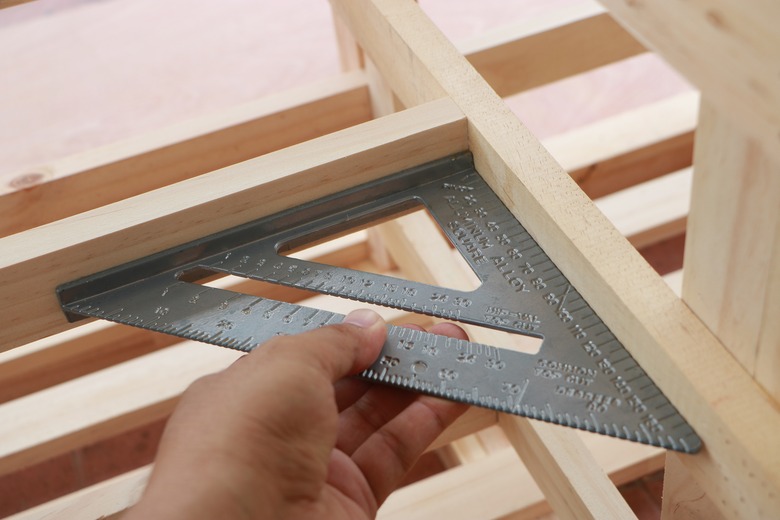How To Find The Angles Of A Right Triangle
Add the values of the three angles in any triangle, and you'll get 180 degrees. If you have a right triangle, one of its angles is 90 degrees by definition. That means the sum of the other two angles has to be 90 degrees, and if you know one of them, you can immediately find the other. But how do you find the angles if you don't know either? The answer is to rely on the other important property of the triangle, the lengths of its sides. They are related to the magnitude of the angles.
TL;DR (Too Long; Didn't Read)
Find the angles in a right triangle by calculating their sine, cosine or tangent, which are functions of the lengths of the sides of the triangle.
Sine, Cosine and Tangent
Sine, Cosine and Tangent
When you choose which of the two angles (ø) in a right triangle you want to find, you establish three sides in relation to it. The line that touches the angle and extends to the 90-degree angle is called the adjacent side, while the side opposite the angle is the opposite side. The hypotenuse is always the side opposite the right angle. Based on these definitions, mathematicians use three ratios that define the angle in terms of the lengths of the sides:
**Sine (sin)** is the ratio of the opposite side to the hypotenuse:
\(\sin ø = \frac{\text{opposite}}{\text{hypotenuse}}\)
**Cosine (cos)** is the ratio of the adjacent side to the hypotenuse:
\(\cos ø = \frac{\text{adjacent}}{\text{hypotenuse}}\)
**Tangent (tan)** is the ratio of the opposite side to the adjacent side:
\(\tan ø = \frac{\text{opposite}}{\text{adjacent}}\)
Each ratio of each pair of lines corresponds to a particular angle, and these ratios are tabulated along with the angles they define. If you can measure the lengths of at least two of the sides of a right triangle, all you have to do is calculate the sine, cosine or tangent of the angle and use a table to look it up.
A Ladder Against a Wall
A Ladder Against a Wall
One of the best known real-world applications of these principles is a ladder resting against a vertical wall. The magnitudes of the angles the ladder forms with the ground and the wall are all-important. If the angle against the wall is too small, the ladder will fall backward, while if the angle on the ground is too small, the ladder will slip. Since the angle between the wall and the ground is 90 degrees, you can calculate the two angles the ladder makes using sine, cosine or tangent, and in so doing, you might prevent an accident.
1. Measure the Length of the Ladder
The ladder forms the hypotenuse of the right triangle.
2. Measure the Distance From the Ladder to the Wall
This distance is the adjacent side when determining the angle the ladder makes with the ground.
3. Find the Angles
Use cosine tables to find the angle the ladder makes with the ground. Calculate the ratio of the adjacent side to the hypotenuse, and then look up the ratio in a table of cosines to find the corresponding angle.
Calculate the angle the ladder makes with the wall by subtracting the angle you just found from 90. Alternatively, you can find the value of this angle using a sine table.
Example
Example
A 20-foot ladder is resting against the side of a house, and the distance from the base of the ladder to the foundation is 12 feet. What are the angles the ladder makes with the ground and the house?
Calculate the cosine of the angle the ladder makes with the ground. It's
\(\frac{12}{20} = 0.6\)
Using a table of cosines (or a scientific calculator), you'll find the angle to be almost exactly 53 degrees. This makes the angle of the ladder against the wall
\(90 – 53 = 36 \text{ degrees}\)
TL;DR (Too Long; Didn't Read)
If you're using your calculator, and you know the cosine of an angle, press the cos-1 key to find the angle. The same applies to sine and tangent.
Cite This Article
MLA
Deziel, Chris. "How To Find The Angles Of A Right Triangle" sciencing.com, https://www.sciencing.com/angle-right-triangle-8159743/. 3 November 2020.
APA
Deziel, Chris. (2020, November 3). How To Find The Angles Of A Right Triangle. sciencing.com. Retrieved from https://www.sciencing.com/angle-right-triangle-8159743/
Chicago
Deziel, Chris. How To Find The Angles Of A Right Triangle last modified March 24, 2022. https://www.sciencing.com/angle-right-triangle-8159743/
